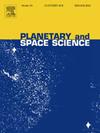Modeling the interstellar dust detections by DESTINY+ I: Instrumental constraints and detectability of organic compounds
IF 1.7
4区 物理与天体物理
Q3 ASTRONOMY & ASTROPHYSICS
引用次数: 0
Abstract
The DESTINY spacecraft will be launched to the active asteroid (3200) Phaethon in 2025. The spacecraft will be equipped with the DESTINY Dust Analyzer (DDA) which will be a time-of-flight impact ionization mass spectrometer. In addition to the composition of impacting dust particles, the instrument will measure the particle mass, velocity vector, and surface charge. Here, we study the detection conditions of DDA for interstellar dust during the DESTINY mission. We use the interstellar dust module of the Interplanetary Meteoroid environment for EXploration model (IMEX Sterken et al., 2013; Strub et al., 2019) to simulate the flow of interstellar dust through the Solar System. Extending earlier work by Krüger et al. (2019b) we consider the entire DESTINY mission, i.e. the Earth-orbiting phase of the spacecraft during the initial approximately 1.5 years after launch, the nominal interplanetary mission phase up to the Phaethon flyby, and a four-years mission extension beyond the Phaethon flyby. The latter may include additional asteroid flybys. For predicting dust fluxes and fluences we take into account a technical constraint for DDA not to point closer than towards the Sun direction for health and safety reasons of the instrument and in order to avoid electrical noise generated by photoelectrons. For the Earth orbiting phase after launch of DESTINY our simulations predict that up to 28 interstellar particles will be detectable with DDA in 2026. In the following years the interplanetary magnetic field changes to a focussing configuration for small () interstellar dust particles. This increases the total number of detectable particles to 50 during the interplanetary mission of DESTINY in 2027. In 2028 and 2029/30 approximately 160 and 190 particles will be detectable, respectively, followed by about 500 in 2030/31. We also make predictions for the detectability of organic compounds contained in the interstellar particles which is a strong function of the particle impact speed onto the detector. While organic compounds will be measurable only in a negligible number of particles during the Earth orbiting and the nominal interplanetary mission phases, a few 10s of interstellar particle detections with measurable organic compounds are predicted for the extended mission from 2028 to 2031.
用DESTINY+ I模拟星际尘埃探测:仪器约束和有机化合物的可探测性
命运+宇宙飞船将于2025年发射到活动小行星(3200)法厄同。该航天器将配备命运+尘埃分析仪(DDA),这将是一个飞行时间撞击电离质谱仪。除了撞击尘埃颗粒的组成外,该仪器还将测量颗粒质量、速度矢量和表面电荷。在这里,我们研究了命运+任务期间DDA对星际尘埃的探测条件。我们使用星际尘埃模块的星际流星体环境探索模型(IMEX Sterken et al., 2013;Strub et al., 2019)来模拟星际尘埃在太阳系中的流动。扩展kr格尔等人(2019b)的早期工作,我们考虑整个DESTINY+任务,即在发射后大约1.5年的初始阶段,航天器的地球轨道阶段,名义的行星际任务阶段,直到法厄同飞越,以及法厄同飞越之后的四年任务扩展。后者可能包括额外的小行星飞越。为了预测尘埃通量和影响,我们考虑到DDA的技术限制,即为了仪器的健康和安全原因,不能指向太阳方向超过90°,并且为了避免光电子产生的电气噪声。在“命运+”发射后的地球轨道阶段,我们的模拟预测,到2026年,DDA将探测到多达28个星际粒子。在接下来的几年里,行星际磁场改变为一个聚焦小(小于0.1μm)星际尘埃粒子的结构。在2027年的“命运+”星际任务期间,这将使可探测粒子的总数增加到50个。在2028年和2029/30年,将分别检测到约160和190个颗粒,随后在2030/31年将检测到约500个颗粒。我们还预测了星际粒子中所含有机化合物的可探测性,这是粒子撞击探测器速度的一个强函数。虽然在地球轨道和名义的行星际任务阶段,有机化合物只能以可忽略不计的粒子数量进行测量,但预计在2028年至2031年的扩展任务期间,将有几十次星际粒子检测到可测量的有机化合物。
本文章由计算机程序翻译,如有差异,请以英文原文为准。
求助全文
约1分钟内获得全文
求助全文
来源期刊

Planetary and Space Science
地学天文-天文与天体物理
CiteScore
5.40
自引率
4.20%
发文量
126
审稿时长
15 weeks
期刊介绍:
Planetary and Space Science publishes original articles as well as short communications (letters). Ground-based and space-borne instrumentation and laboratory simulation of solar system processes are included. The following fields of planetary and solar system research are covered:
• Celestial mechanics, including dynamical evolution of the solar system, gravitational captures and resonances, relativistic effects, tracking and dynamics
• Cosmochemistry and origin, including all aspects of the formation and initial physical and chemical evolution of the solar system
• Terrestrial planets and satellites, including the physics of the interiors, geology and morphology of the surfaces, tectonics, mineralogy and dating
• Outer planets and satellites, including formation and evolution, remote sensing at all wavelengths and in situ measurements
• Planetary atmospheres, including formation and evolution, circulation and meteorology, boundary layers, remote sensing and laboratory simulation
• Planetary magnetospheres and ionospheres, including origin of magnetic fields, magnetospheric plasma and radiation belts, and their interaction with the sun, the solar wind and satellites
• Small bodies, dust and rings, including asteroids, comets and zodiacal light and their interaction with the solar radiation and the solar wind
• Exobiology, including origin of life, detection of planetary ecosystems and pre-biological phenomena in the solar system and laboratory simulations
• Extrasolar systems, including the detection and/or the detectability of exoplanets and planetary systems, their formation and evolution, the physical and chemical properties of the exoplanets
• History of planetary and space research
 求助内容:
求助内容: 应助结果提醒方式:
应助结果提醒方式:


